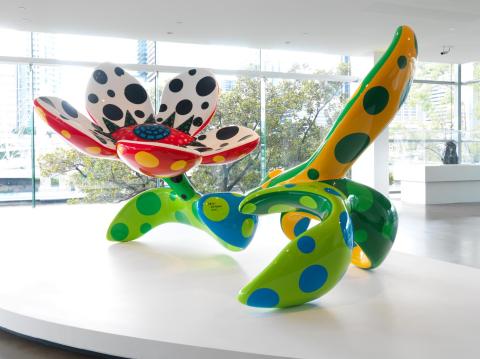ESSAY: Kusama’s pumpkins and flowers
By Reuben Keehan
‘We Can Make Another Future’ September 2014
Pumpkins and flowers are important motifs in Yayoi Kusama’s work, fascinations that extend from the artist’s youth. Their symbolism reflects many of the artist’s conceptual preoccupations as well as her disregard for dichotomies: they connote life and death, celebration and mourning, masculinity and femininity; while their complex, organic and fragile forms find echoes throughout Kusama’s practice, not least in its celebration of human sensuality. Formally, the use of these motifs is consistent with the blending of the manufactured and the organic in her print and sculptural work. Their random, almost mutant, appearance highlights the degree to which the natural world appears as strange and uncanny in modern culture, while at the same time maintaining connotations of fertility and growth.
In plentiful supply, thanks to her family’s nursery business, flowers flourished in Kusama’s first reported childhood visions, consuming entire rooms and communicating ominously with the artist. As a means of intuitively working through these experiences, flowers figure in many of Kusama’s earliest paintings and drawings, her subjects drawn from the fields near her family home. In a famous photograph of the artist at age ten, she is almost obscured by enormous dahlias. Likewise, pumpkins were also in abundance in the family storehouse, such that the family came to rely on them when food supplies were disrupted during World War Two. Despite having consumed the vegetable to the point of nausea at the time, Kusama has maintained an attachment to its irregular, bulbous form.
Pumpkins and flowers first appeared in Kusama’s paintings and drawings executed during her studies of nihonga (traditional Japanese painting) at the Kyoto Municipal School of Arts and Crafts. Their unpredictable, organic shapes are reminiscent of the automatic drawing technique of postwar Surrealism, the influence of which can be found in Kusama’s early work, and indeed across much Japanese avant-garde art of the early 1950s. The flowers in particular reappeared in her ‘happenings’ of the late 1960s, in the sympathetic environment of the anti-war counterculture, as they fitted neatly into the context of the ‘flower power’ movement of the time. More poignantly, they feature in the melancholic collages she made after returning to Japan in the early 1970s, as a way of dealing with the deaths of her lover, artist Joseph Cornell, and her father, Kamon.
Pumpkins would find renewed importance in Kusama’s practice as it expanded in scale in the 1980s and 1990s; the motif was worked and reworked through an ongoing portfolio of prints, as in the eponymous Pumpkin 1992. So too would the flowers, which emerge menacingly from masses of tendrils in her human-scaled soft sculptures of the 1980s. In addition, Kusama’s 1998 novel Violet Obsession describes the experiences of a young girl, persecuted by her mother, who discovers she can converse with flowers as agents of the universe. Both forms would be channelled into a far more celebratory series of sculptures, executed since the mid 1990s. Monumental in scale, these works consist of floral forms that are at once simplified and fantastical, and finished in polka-dotted planes of vivid colour. The reclining pose of Flowers that bloom at midnight 2011 is almost corporeal, recalling images of the young Kusama herself in recline, most famously in Untitled 1966 — the artist, her naked flesh covered in polka dots, poses provocatively on her soft sculpture sofa, Accumulation no. 2 1964.
For all the strange and overwhelming power of its scale and alien appearance, this air of playful albeit uncanny sexuality, in concert with the work’s comical styling, pristine surfaces and exuberant tones, is decidedly joyous. Flowers that bloom at midnight contrasts strongly with the darker function flowers performed in Yayoi Kusama’s earlier works; here, sensuality is a source of confidence, rather than anxiety.
Connected objects

Pumpkin 1992
- KUSAMA, Yayoi - Creator
Metadata, copyright and sharing information
About this story
- Subject
